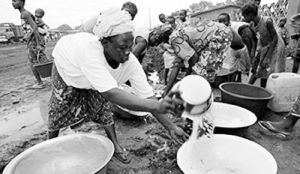By JULIUS PHIRI –
ACCESS to water and sanitation facilities in Zambia is low particularly in rural areas.
Currently, Zambia is 74 per cent of water and 80 per cent of sanitation. Access to sanitation can be as low as 42 per cent in urban areas and 11 per cent rural areas.
The main traditional sources of water in many parts of rural areas are streams and unprotected wells both of which are easily polluted, causing disease and ill-health.
Of the 13 plus million people, only few have access to clean water and sanitation.
According to Millennium Development Goals (MDGs), number seven was to ensure environmental sustainability.
In line with the goal, the country has already met the target on water access, while the target on sanitation is far from being attained by 2015.
Less than few months from now, Zambia together with other countries will cross to another year which was crucial with so many goals.
The national coverage of water supply in the country now stands at 75.4 per cent, while 53.8 per cent was for sanitation.
As usual, water and sanitation initiatives are complemented by hygiene education activities to ensure that the health benefits for the community can be maximised.
National Water Supply and Sanitation Council (NWASCO) public relations and communications manager Rose Tembo said the Government’s vision for the sector was 100 per cent coverage of water and 90 per cent coverage of sanitation by 2030.
She said the demand for water was a complex indicator to compute as the sectors needing water were many.
As of December last year, out of a total urban population of 5,965,575 only 5,006,510 had access to water, while the total population served with sewerage was only 3,503,84. Ms Tembo said the national urban water coverage was 83.9 per cent, while the national urban sanitation coverage was 58.7 per cent.
She stated that without safe sanitation, safe drinking water poses a major challenge to attain.
“Lack of safe sanitation is a major cause of contamination, therefore, water and sanitation are integrally related and equally important for a life of health and dignity,” she said.
Ms Tembo said good sanitation and hygiene improves health adding that poor controlled waste means daily exposure to unpleasant environment.
Sanitation is the disposal of human excreta to prevent disease and safeguard privacy and dignity.
In fact, sanitation was the hygienic means of preventing human contact from hazards of wastes to promote health.
Ms Tembo said sanitation coverage as per NWASCO definition was the ratio of population with access to adequate sanitation which includes factors such as distance and number of people per sanitary facility.
She said all people have a responsibility to ensure to enjoy a pleasant environment.
“For water providers, they are responsible for treating and supply of adequate water to customers, collecting and disposing of waste water in their service areas and extending sanitation services to areas not serviced,” she stated.
She said the consumers must put sewer systems to good use and for the intended purpose, thereby allowing the free flow of the sewer effluent to septic tanks and sewer ponds.
Ms Tembo said the construction of pit latrines properly for maintenance and ensures hygiene.
She said vandalism of sewer systems would be fought at all costs because it was retrogressive and costly to repair once the blockage has occurred.
Ms Tembo said the Devolution Trust Fund (DTF) under NWASCO had set aside K32 million for water and sanitation projects for this year.
She said the projects are for accelerating service provision in low-income areas.
“NWASCO‘s mandate is that of regulation and the Ministry of Local Government and Housing would know how much investments have been received for the year. However, there are the following projects that are being implemented,” she said.
Current investments in the sector include 75 million Euros from European Investment Bank for Chingola, Chililabombwe and Mufulira projects, US$63 million for African Development Bank (AfDB) for Kitwe and Kalulushi, $25 million from Japan International Cooperation Agency (JICA) for Ndola, $11 million from German Development Bank (KFW) for Eastern Province, $85 million from Danish International Development Agency(DANIDA) for Kafubu and $355 million from Millennium Challenge Corporation (MCC) for Lusaka.
Germany Ambassador to Zambia Bernd Finke, who was touring Eastern Water and Sewerage Company (EWSC) facilities recently observed that he was happy that his government had supported infrastructure developments in the water sector for the past 20 years.
He said his government had been rendering the support to the Government of Zambia for the past 50 years in different areas.
“Eastern Province is one of the provinces which have benefited from our support. About 68 per cent of the general population in the province is enjoying clean water through our support,” he said.
In another development, EWSC Wamuwi Changani challenged the media to be covering more stories on water and sanitation for people to fully understand.
In a nutshell Zambia has made significant progress providing access to improved water sources.







